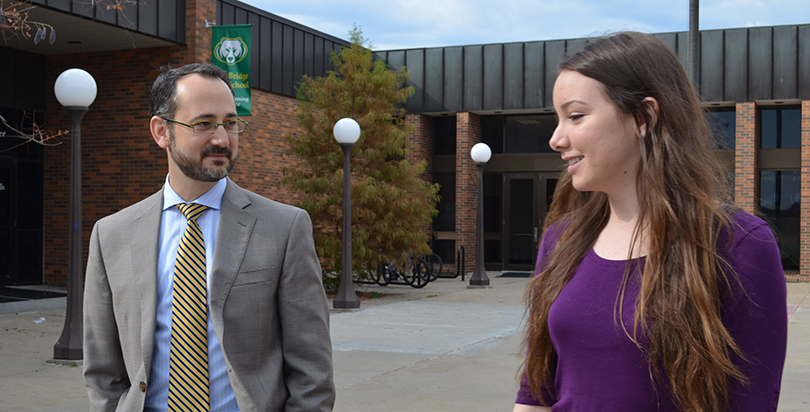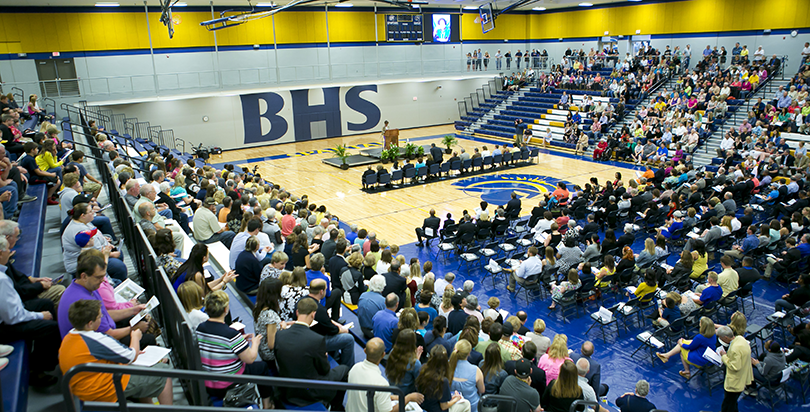You know the routine. The alarm goes off, you roll over, fumble blindly for your phone, and manage to tap the tiny snooze button. Ah, peace. You’ve won yourself a few extra minutes of precious sleep.
A few years ago, Jilly Dos Santos, then a sophomore at Rock Bridge High School in Columbia, Missouri, was a little too familiar with the wake-up delay dance. She typically stayed up until 1 or 2 a.m. doing homework and was habitually late for her school’s first-period 8 a.m. bell.
“I had trouble waking up in the morning and trouble getting to bed at night, which is a prime example of what early start times can do to adolescents,” she told The Seventy Four.
Now a freshman in college, the 19-year-old can look back with satisfaction knowing she played a key role in protecting current and future Columbia students from suffering the same soporific fate.
Getting the 18,000-student district there was no easy feat.
In 2013, armed with research on adolescent sleep cycles and aided by her peers, who carried out a district-wide social media blitz, Dos Santos championed the effort to convince the school board that a plan (prompted by the construction of a new high school) to start all high schools at 7:20 a.m. was a bad idea.
After heated debate over two months, officials voted to move the start time at Columbia’s four high schools from 7:45 a.m. to between 8:55 and 9:10 a.m., giving students an extra hour-plus in the mornings.
Two years in, the consensus around the district is that sure, there are snags, but ultimately, the later start time has contributed to noticeable gains at Columbia’s public schools.
“Our kids seem to be more awake and more eager to learn,” said Battle High School Principal Kim Presko, who often observed lethargic freshman students in 8 a.m. first-period classes.
And they still make it to sports and extracurricular activities despite occasional scheduling conflicts.
Schools Superintendent Peter Stiepleman said the number of annual out-of-school suspensions has dropped by nearly 1,000 since 2012, and graduation rates have climbed from 82.7 to 90.2 percent.
It’s hard to show a direct correlation between later start times and fewer suspensions, Stiepleman said, but he and his staff are certain that when students are well-rested, eat nutritious meals and get regular exercise, they’re better prepared to succeed in school.
“If we can improve our kids’ ability to get a better night’s sleep, we should do it,” he said.

Columbia Public Schools Superintendent Peter Stiepleman and senior Jilly Dos Santos talk outside Rock Bridge High School in fall 2014.
Photo: Courtesy Columbia Public Schools
Hundreds of schools in dozens of states have delayed start times in recent years as the Start School Later movement has gained momentum, propelled by a growing body of research that supports the idea that adolescents’ overall well-being and academic performance improves when school start times are delayed.
Adolescents who don’t get enough sleep are more likely to be overweight, use drugs and alcohol, perform poorly in school and suffer from depressive symptoms, according to the Centers for Disease Control and Prevention, which recommends 8.5 to 9.5 hours of sleep.
According to 2011-12 data reviewed by the CDC, in 42 states, 75 to 100 percent of public schools started before 8:30 a.m., making it difficult for students to get the recommended amount of rest. The CDC found that two in three high school students in the U.S. get less than eight hours of sleep on school nights.
In the last few months, school districts in Durham, North Carolina, and Lincolnshire, Illinois, have made the switch to a later start, following early adopters like Arlington, Virginia, and Denver, Colorado.
On Nov. 18, Seattle Public Schools became one of the largest districts in the country to push start times past 8:30 a.m. Beginning next school year, all the city’s high schools, most middle schools and some K-8 schools will start at 8:45 a.m., The Seattle Times reported. The school board in Greenwich, Connecticut is weighing a similar proposal.
State legislatures have woken up to the movement too. New Jersey and Maryland passed bills last year directing studies on the impacts of later start times. Federal legislation to compel the U.S. education department to seriously examine the relationship between school start times and adolescent health, well-being and performance has been haltingly pursued for nearly two decades.
The initial change agent in Columbia, however, wasn’t the research (although school officials did study it) but the opening of a new high school to accommodate a growing number of students, many from economically disadvantaged families.

In June 2013, students gathered for a dedication ceremony at the newly opened Battle High School in the Columbia school district in Missouri.
Photo: Courtesy Columbia Public Schools
Officials spent months working through a complicated transportation overhaul that was necessary to add the 1,400 students who now attend the new Battle High School into the district’s sprawling busing system.
Spread over 300 square miles at the midway point between St. Louis, Mo., and Kansas City, Columbia had 362 bus routes before the switch and 485 after. Buses annually travel 2.6 million miles, up from 2.2 million in 2012.
It’s a unique test case where administrators bypassed some of the logistical roadblocks that other districts have faced when considering a new start time.
“Our opportunity was that we were opening up a new high school and we were going to be forced to come up with a new system for busing,” Stiepleman said. “You really have to choose the right moment and it was the right moment when we opened up the school.”
In the winter of 2013, the transportation committee had nearly finalized the new scheduling arrangement — high schools would start first, at 7:20 a.m., rather than 7:45 a.m., followed by middle and elementary schools. Buses would pick up and drop off students in three tiers, rather than two as in the past.
Less than a week before the board was set to vote on it, Dos Santos and her classmates learned about it from teachers in their Advanced Placement World History class.
If students felt strongly about starting their day earlier, they should act — and quickly — Dos Santos’ teachers urged.
Dos Santos jumped into the fray. The board meeting was in five days. She would make her case against an earlier start time in front of the board, administrators, teachers and parents. That night, she pulled an all-nighter to create a petition, a Facebook page and a Twitter account. She sent an email blast to teachers to gather their support and recruited friends to make posters, which they plastered around the school the next day.
She sent out tweets like this one, posted at 5:36 a.m. on Jan. 10, 2013: “Good morning everyone! I hope you're all up, because if the proposed high school start times go through, this'll be everyday. #StudentsSay.” On Twitter, the campaign soon captured the attention of advocates involved in the national Start School Later movement, who directed Dos Santos toward scientific research to support her case.
Two months later, she addressed the board for the third and final time, and members voted 6-1 to adopt a new bell schedule in which middle schools start first, followed by elementary schools and, lastly, high schools.
Battle High School senior Brittany Brown, 17, is among the many students who’ve felt the impact of Dos Santos’ efforts.
Brown used to start her school day at 8 a.m. as a ninth-grader. The change that gave her an extra hour starting in her sophomore year allowed her to create her morning routine around her needs. She still gets to school early, for a “zero hour” 7:30 a.m. elective strength training class, but it’s by choice. She built in a first-period study hall so she can catch up on homework.
Brown, who is now senior class president, said the more flexible morning schedule has allowed her to participate in three years’ worth of extracurriculars that she wouldn’t have had time or energy to do with a mandatory early morning academic class.
“I thank God for a late start because I know if I had to go to school at 7 o’clock in the morning, oh man, I don’t think I’d be (class) president.”
Not everyone is grateful.
Some parents have complained that they’ve had to find alternative after-school care for younger children because older siblings are no longer dismissed in time to watch them.
For a relatively small group of students, officials said, instruction time is lost because high school athletes leave class early to travel to games in districts with traditional schedules. Some students with after-school jobs are pinched to get to them on time.
The district has responded by putting WiFi on buses so students can do homework while traveling. Many sports practices and club meetings are now held in the mornings. And the district has expanded its online course offerings.
It’s not perfect. But ultimately, the benefits of the later start time easily outweigh the costs, school officials agree.
“There are so many possible pitfalls for a district and this was a community that was willing to do it and I think it’s been a really positive outcome,” Stiepleman said.
Even King, the sole board member to vote against the plan in March 2013, admits that two years in, “for the most part, everybody has adjusted.”
“Our community was really excited about the late start for high schools, which I think is working out well,” said King, who has a daughter in middle school and a son in high school.
In an interview, King said she never opposed a later start for the high schools, but voted against the schedule because at the time, she felt it was important to stick with the original recommendation of the committee, which had high schools start first. The rationale was both to accommodate the needs of the bus company and limit the disruption to students and families, she indicated.
On the flip side, middle schoolers actually got stuck with an earlier start time — 7:30 a.m. instead of 8 a.m. Starting the middle schools later, closer to 9 a.m., is something the district may explore changing in the future, but it’s prohibitively expensive now, officials said in late 2015. In early November, officials estimated it would cost $1 million to tweak the system that way.
Dos Santos, who graduated from Rock Bridge High School in June, seems content with the legacy she’s left her younger peers in the district.
And she remains determined to protect her sleep while carrying a full credit load this semester at Middlebury College in Vermont. So it’s no coincidence that none of her classes start before 9:30 a.m.
“It was totally my plan,” she laughed.
Get stories like these delivered straight to your inbox. Sign up for The 74 Newsletter


;)
